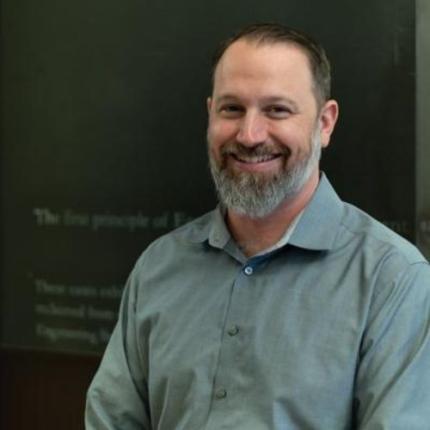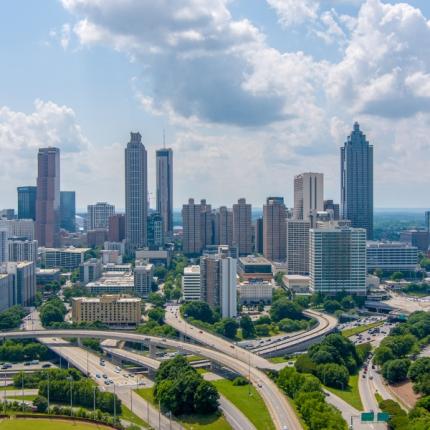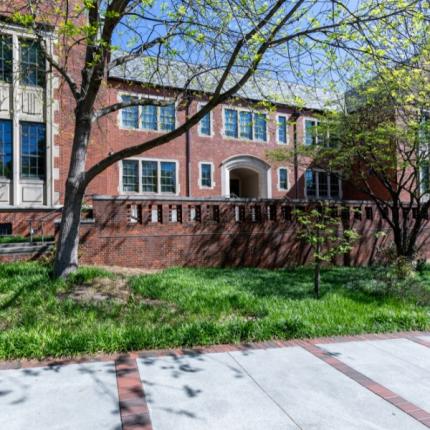Renewable energy production is increasing in the United States, but so is oil and gas production. Despite the escalating effects of carbon emissions on the climate, the U.S. set records for crude oil and natural gas output in 2023.
Researchers say that accelerating the transition to renewable energy can help mitigate climate change, enhance energy security, and stimulate economic growth. Three such energy experts at the Ivan Allen College of Liberal Arts — an economist, a policymaker, and a historian — chart some of the challenges and opportunities on the path to a fully renewable energy grid in the U.S.
"There is a common misconception that fossil fuels provide energy security. Nothing could be further from the truth."
— Germán Vergara, associate professor of history
Regents' and Brook Byers Professor of Sustainable Systems, School of Public Policy
Associate Professor
School of Economics
Associate Professor
School of History and Sociology
1. How can we ensure energy security while transitioning to renewable energy sources?
Vergara: There is a common misconception that fossil fuels provide energy security. Nothing could be further from the truth. How can relying on a finite energy source with randomly scattered deposits that require sophisticated and vulnerable infrastructure to extract, transport, and use be considered a safe proposition? Just ask Texas, whose fossil-fuel-based electric grid was paralyzed because of a cold snap.
The best option is to develop a renewable energy mix that combines multiple energy sources so that one can compensate for the limitations of the others. There is no silver bullet; every region must find the right combination. Georgia, for example, has enormous solar potential and could combine it with wind, water, and nuclear (forgetting for a moment the problem of storage for nuclear waste, the finite amount of uranium reserves, and the huge cost and time needed to build nuclear plants, which Georgia has experienced first-hand).
Brown: One way we can improve energy security is to focus on energy storage and demand response. Demand response is the use of technology and incentives to encourage customers to shift their energy use during peak times to reduce the load on the grid.
Oliver: Renewable energy generally supports energy security because it is more distributed and localized. Unlike oil, there is no need to "import" hydro, wind, or solar energy because we have it here in abundance.
Dive deeper: Brown's 2021 study with School of Public Policy Ph.D. student Oliver Chapman found that decarbonizing Georgia's grid with more renewables will require more flexible resources and dynamic energy products.
2. What are the most effective ways to promote renewable energy adoption?
Brown: 100% renewable energy pledges are powerful. Atlanta was the first major city in the Southeast to make such a pledge.
Oliver: That's a very broad question because different policies work differently for different sectors. Promoting renewable energy adoption by consumers is very different from promoting adoption by commercial businesses or energy utilities. Each has a different set of incentives that they respond to, so it takes different kinds of policies to promote adoption.
Vergara: National governments, including the U.S., should develop a publicly owned renewable energy sector that will meet the interests of the majority of the population for affordable and reliable renewable energy. Absent that, governments should at least subsidize renewable energy on a large scale. At the same time, they should stop subsidizing fossil fuels.
Governments should also invest heavily in transforming cities to make them more sustainable, not only because over half of the global population lives in cities, a percentage that will only grow in the following decades, but also because urban areas represent a low-hanging fruit in the transition to low-carbon societies.
We already have the technologies and know what works: public transit, dense and walkable cities, biking infrastructure, and increased urban food production. An additional benefit would be the possibility of reverting some of the damage that the interstate highway system and car-oriented urban design inflicted on poor, predominantly Black neighborhoods across the country. Many of those neighborhoods were dense, had a variety of businesses, and provided numerous services to their residents within a short distance. They also had a tight-knit community. Freeways, asphalt, and broken communities replaced all of that.
"There are no truly environmentally benign energy sources."
— Matthew Oliver, associate professor of economics
3. How do different energy sources impact the environment?
Oliver: There are no truly environmentally benign energy sources. Fossil fuels create pollution and carbon emissions in varying quantities per unit of energy. Hydro disrupts natural river systems, impedes fish migrations, and displaces communities in areas flooded by reservoirs. Wind turbines negatively impact natural views and kill birds. Utility-scale solar requires a vast land area.
Vergara: The impacts of fossil fuels include air pollution, which causes seven million deaths globally per year, mountaintop removal for coal extraction, which has devastated Appalachia, ocean acidification, and global warming, to name the most important ones. Regarding renewable energy, no source is entirely free of environmental impacts. The most important one is the effects of mining metals for batteries, such as lithium.
Dive deeper: Brown's 2017 report for the Oak Ridge National Laboratory explores the damaging effects of the U.S. power sector on air, water, land, and environmental justice.
4. What are the economic implications of integrating renewable energy into the grid?
Brown: Georgia imports coal and natural gas to generate electricity, sending money out of state. Georgia has excellent solar resources and is hosting QCells, one of the largest solar panel manufacturers in the Western Hemisphere, located in Dalton. Given the competitive price of solar power, Georgia's economy and workforce will thrive by expanding its reliance on this renewable resource.
Oliver: Whew. One could write an entire dissertation on this. One of the biggest problems is that wind and solar are intermittent, so generation is highly variable due to natural variations in weather. This puts pressure on electricity systems and markets, mainly because electricity cannot be stored at a sufficiently large scale at a low cost.
Electricity system managers must, therefore, respond to variation not only on the demand side but now also on the supply side, increasing the total variability in the system. Effectively managing this additional variation is costly (and poorly managing it is even more costly).
"Access to clean energy should be seen as a human right, equal to housing, healthcare, and education. As long as energy is just a market commodity, access will remain dependent on the vagaries of market forces, and the outcome will inevitably be unequal."
— Vergara
5. How can energy policy and technology help mitigate climate change?
Oliver: The most effective thing to do would be to put a price on carbon emissions. This can be achieved through a carbon tax or a carbon cap-and-trade system. Either would cause major CO2 emitters to "internalize" the cost to society of their emissions, thereby incentivizing them to reduce emissions to a "socially optimal" level.
Brown: We need to decarbonize the economy by internalizing the cost of pollution to the companies that create it. Right now, they are being given a free ride.
Establishing a market where carbon offsets and renewable credits can be bought and sold creates economic incentives for businesses and individuals to reduce emissions and invest in renewable energy.
Vergara: To address climate change, we don't really need substantially different technologies from the ones we currently have. Wind, water, and solar are already cheaper than fossil energy in many, if not most, places.
Besides, these proven technologies don't come with the extraordinary risks associated with dubious techno-fixes such as carbon capture, let alone pie-in-the-sky schemes such as space mirrors or the use of aerosols, whose unintended consequences could be worse than those of global warming.
6. How can we address unequal access to energy and environmental resources?
Brown: I am an avid advocate of energy efficiency as the No. 1 fuel. Many disadvantaged communities have poor, leaky, old housing, which results in high levels of energy poverty.
Vergara: Governments should treat energy — especially clean, renewable energy — as a public good. Access to clean energy should be seen as a human right, equal to housing, healthcare, and education. As long as energy is just a market commodity, access will remain dependent on the vagaries of market forces, and the outcome will inevitably be unequal.
Dive deeper: Brown's 2024 Sierra Club report, authored with student researchers in the School of Public Policy, finds that Black households in Georgia face disproportionately high energy burdens due to historic discrimination and disinvestment in infrastructure.
Interested in learning more?
Check out the interdisciplinary Master of Sustainable Energy and Environmental Management, which can also be completed as a graduate certificate. Or, get involved with the Climate and Energy Policy Laboratory!







